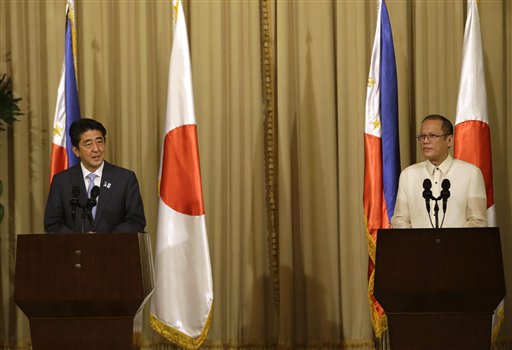
Japanese Prime Minister Shinzo Abe, left, delivers his response during a joint press conference with President Benigno Aquino III Saturday at Malacañan Palace in Manila. AP
MANILA, Philippines—President Benigno Aquino III and Japanese Prime Minister Shinzo Abe on Saturday pledged a common stance against maritime aggression in Asia as both countries confront China in separate territorial disputes.
Following a meeting with Aquino in Malacañang, Abe announced that Japan will provide a concessional loan to build 10 patrol boats for the Philippine Coast Guard.
The Philippines has already received two coast guard ships from the United States as it seeks to build a deterrent naval force after China took control of a disputed shoal off the northwestern Philippines last year, and more recently, established a presence farther south in the West Philippine Sea (South China Sea).
China’s assertiveness to lay claim to most of the West Philippine Sea after decades of relative calm has alarmed Manila, which has turned to the United Nations to seek international arbitration. Beijing has indicated it won’t cooperate.
The visit by the Japanese prime minister, who gained a fresh mandate as his party won a landslide victory in last week’s elections, was welcomed by Aquino as proof of the two nations’ strategic partnership.
“We reviewed the security challenges that confront our nations and pledged to cooperate in advancing our common advocacy for responsible action from international players,” said Aquino, reading from a prepared statement following the talks at the Palace.
“We believe that can be done by upholding the rule of law in international affairs, and by finding just and peaceful solutions to our territorial disputes and maritime concerns—so that we may create a secure and stable environment that leads to our collective progress,” said the President.
In line with this, the two leaders agreed to strengthen “maritime cooperation, which is a pillar of our strategic partnership,” according to Aquino.
Japan will deliver later this year the “multi-role response vessels” for the PCG and provide communication systems for coast patrol.
“At the core of our strategic partnership are mutual respect, good will, and a determination to see each other prosper. As neighboring nations, we believe that the growth of our peoples will redound to the further development of our region. On this note, I thank the Prime Minister and the people of Japan for their continuous support of the peace process in Mindanao,” said Aquino.
Abe, for his part, read a prepared statement describing the Philippines as a “strategic partner which whom we share fundamental values and many strategic interests.”
Abe said that a key element of Japan’s efforts to revive its economy and promote regional peace and security lies in closer relations with the 10-member Association of Southeast Asian Nations.
Asean includes the Philippines and Vietnam, both of which have disputes with China in the West Philippine Sea.
The meeting in Manila, which is the last leg of Abe’s three-day visit to Southeast Asian capitals, came after Japan scrambled jets on Wednesday to keep watch on a Chinese Y-8 early warning plane flying over international waters between Japan’s southern Okinawa island and an outer island relatively close to the disputed area in the East China Sea.
The Chinese Defense Ministry issued a statement defending the right of its aircraft to operate in the area.
Around the same time the Chinese fighter jet was sighted, Japan’s coast guard reported the appearance of four Chinese coast guard vessels near the disputed islands called Senkaku by Japan and Diaoyu by China.
On Friday, China said that ships from its newly formed coast guard confronted Japanese patrol vessels and “sternly declared” China’s sovereignty over the islands.
The uninhabited archipelago is controlled by Tokyo but also claimed by Beijing.
Chinese coast guard ships have also been spotted this week at Mischief Reef (Panganiban Reef) off the western Philippine coast, according to a confidential Philippine government report obtained by The Associated Press. China occupied the vast reef in 1995, sparking protests from rival claimant Manila. With a report from Associated Press